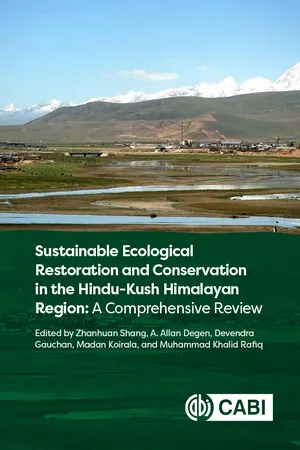
Sustainable Ecological Restoration and Conservation in the Hindu Kush Himalayan Region
A Comprehensive Review
- 400 pages
- English
- ePUB (mobile friendly)
- Only available on web
Sustainable Ecological Restoration and Conservation in the Hindu Kush Himalayan Region
A Comprehensive Review
About This Book
The years 2021 to 2030 have been designated as "The United Nations Decade on Ecosystem Restoration". Ecological restoration and biodiversity conservation efforts face unprecedented challenges, especially in developing countries and areas, such as the Hindu Kush-Himalayan (HKH) region. This huge HKH region, which includes areas in eight separate countries (Afghanistan, Pakistan, Nepal, India, China, Bangladesh, Myanmar and Bhutan), is a biodiversity hotspot with a vast array of ecosystems, landscapes, peoples and cultures. It is known as one of 'the pulses of the world'. However, the HKH is also the world's largest and poorest mountain region, where landscapes and environments have been severely damaged as a result of climate change and human activities. Coordinating conservation and restoration policies, sharing knowledge and funds, and maintaining livelihoods are major challenges and are in urgent need of improvement.This book details the past and current ecological problems in the HKH region, and the threats and challenges that ecosystems and local people face. It pays special attention to developments of transformative adaptations and presents examples of sustainable conservation and ecological restoration management practices.Three primary questions are addressed: (1) Do the existing conservation strategies of international organizations and government policies really protect ecosystems and solve biodiversity problems? (2) Can these management measures be one-time solutions? and (3) What is the strategic framework and scenario prognosis for the future based on the historical trajectory of ecological conservation and restoration in the region?This book is essential reading for ecologists and conservation biologists involved in large-scale ecological restoration projects, along with practitioners, graduate students, policy makers and international development workers.
Frequently asked questions
Information
Table of contents
- Cover
- Title Page
- Copyright
- Contents
- About the Editors
- Contributors
- Preface
- Acknowledgements
- 1 Environmental Problems in the History and Development of the Hindu Kush Himalayan Region
- 2 Biodiversity Assessment for Sustainable Conservation in the Hindu Kush Himalayan Region
- 3 The Environmental Impact on Livelihood and Food Security in the Hindu Kush Himalayan Region: Current and Future Challenges for Nepa
- 4 Challenges of Ecological Conservation and Restoration under the COVID-19 Global Pandemic in the Hindu Kush Himalayan Region
- 5 Ecological Conservation and Restoration in Afghanistan
- 6 Ecological Conservation and Restoration in Bangladesh
- 7 Ecological Conservation and Restoration in Bhutan
- 8 Ecological Conservation and Restoration on the Tibetan Plateau in China
- 9 Ecological Conservation and Restoration in the Indian Himalaya Region
- 10 Ecological Protection and Restoration in Myanmar
- 11 Ecological Restoration in Nepal: A Comprehensive Policy Overview
- 12 Ecological Conservation and Restoration in Pakistan
- 13 Forests: Conservation, Restoration and Sustainable Utilization in the Hindu Kush Himalayan Region
- 14 Conservation and Sustainable Utilization of Rangelands in the Hindu Kush Himalayan Region
- 15 Agriculture: Agrobiodiversity and Sustainable Approaches in the Hindu Kush Himalayan Region
- 16 Function and Conservation of the Montane Desert Ecosystem in the Hindu Kush Himalayan Region
- 17 Wetlands in the Hindu Kush Himalayan Region: Eco-economic Function and Conservation Strategies
- 18 Glaciers and Permafrost: Function and Conservation
- 19 Gender Roles and Practices in Ecological Conservation and Restoration
- 20 Conservation Strategies: Multi-scale Approaches and Policies in the Hindu Kush Himalayan Region
- 21 Strategies for Forest and Grassland Restoration in the Himalayan Regions
- 22 Sustainable Livestock Production in the Hindu Kush Himalayan Region
- 23 Ecosystem Services and Compensation in the Hindu Kush Himalayan Region: Strategies and Suggestions
- Index
- Back Cover